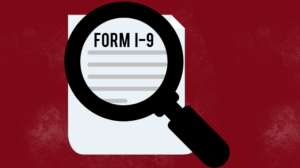
We recently received inquiries from employers asking about I-9 compliance requirements and how to respond to an I-9 Notice of Inspection (NOI) issued by the U.S. Immigration and Customs Enforcement (ICE). The most frequently asked questions are: what is the response timeline and procedure; does this mean my company is being red flagged by ICE; will this affect approved or pending petitions the company has filed with USCIS; what are the consequences if any violation is found; any common pitfalls and how to avoid them, etc.
The purpose of this administrative inspection is to determine whether the employer has violated the prohibitions against hiring or continuing employment of unauthorized aliens and Form I-9 violations. Usually, a 72-hour notice will be given to employers preceding the ICE Form I-9 administrative inspection, unless requested extension is granted. The NOI indicates the date, time, and place for the inspection and the documentation that the employer is requested to produce. Take the time to review all I-9s and/or consult with an immigration lawyer. Once the I-9s and supporting documents are submitted to government, you cannot take them back.
Receiving a NOI does not necessarily mean your company is being red flagged for possible violations. ICE may initiate I-9 inspection randomly or after public complaints. Form I-9 inspection may be conducted either on the employer’s premises, at an agency office, or at the agency’s discretion. Employers that use electronic Form I-9 storage systems need only retrieve and reproduce the forms electronically retained in the storage system and supporting items requested by the inspecting agency.
If you are served with a NOI, carefully read the NOI and any accompanying subpoena. Reach out to the ICE Agent and confirm any unclear information, such as:
-
- The Documents Required. Is ICE only requesting the I‐9 forms or also the supporting documents? Only the I-9 forms for current employees are requested or for terminated employees as well?
- The Format in Which Information Should Be Provided. Some agents want the payroll to be in Excel or Word or other electronic format rather than hard copy.
- The Exact Time and Date the Officer Will be Returning to Pick Up the I‐9 Forms. This information is often not listed and can be negotiated.
- Which Employees are Subject to the NOI? Is ICE requesting forms I‐9s for current employees or for terminated employees as well?
- Which Companies or Locations are Subject to the NOI? This can be an issue if ICE serves the NOI on a branch office or a business unit of a company. Whether or not to raise this is a strategic decision for the attorney and the company. Typically, if ICE serves only a single location of a company and the NOI does not indicate otherwise, ICE is only auditing that location.
Take ICE Agent seriously and keep a copy of everything that is turned over to ICE.
If the employer does not comply with the request to present the forms and supporting documents, ICE may compel production by issuing a subpoena. A delay in the production of the forms and supporting documents may be considered a violation of compliance requirements. After a Form I-9 inspection, ICE will notify the employer as to its results. ICE has the policy to consider the percentage of I-9 forms found in violation of the compliance requirements in determining whether a Notice of Intent to Fine should be issued rather than a warning. The Notice of Intent to Fine contains a proposed fine amount. Employers may request a conference with DHS before or after Notice of Intent to Fine is served on the employer. To avoid a final order, employers must respond to the Notice of Intent to Fine by requesting a hearing before an administrative law judge.
To avoid compliance fines, it is essential for employers, especially high profile employers and those who enroll in E-Verify to implement effective immigration compliance policies and/or adopt a customized immigration compliance program. For example, employers may consider to have a written Form I-9 verification policy which may be used by the compliance staff as a reference as to the requirements of the law. Employers may also consider developing and maintaining a tickler system to keep track of the expiration dates of employee Form I-9 employment authorization documents to allow sufficient time for re-verification. In addition, training on work-site compliance will help the company to develop a culture of compliance which continues to provide staff with confidence that they are performing their compliance tasks correctly. An effective compliance training program is also good evidence that the company treats its compliance responsibilities seriously.
In sum, using tools to self-evaluate the employers’ compliance policy and system is critical to avoid immigration-related compliance liabilities.
Schedule a consultation with our office if you need legal advice on how to handle I-9 forms or attorney’s review on company immigration compliance practice.
